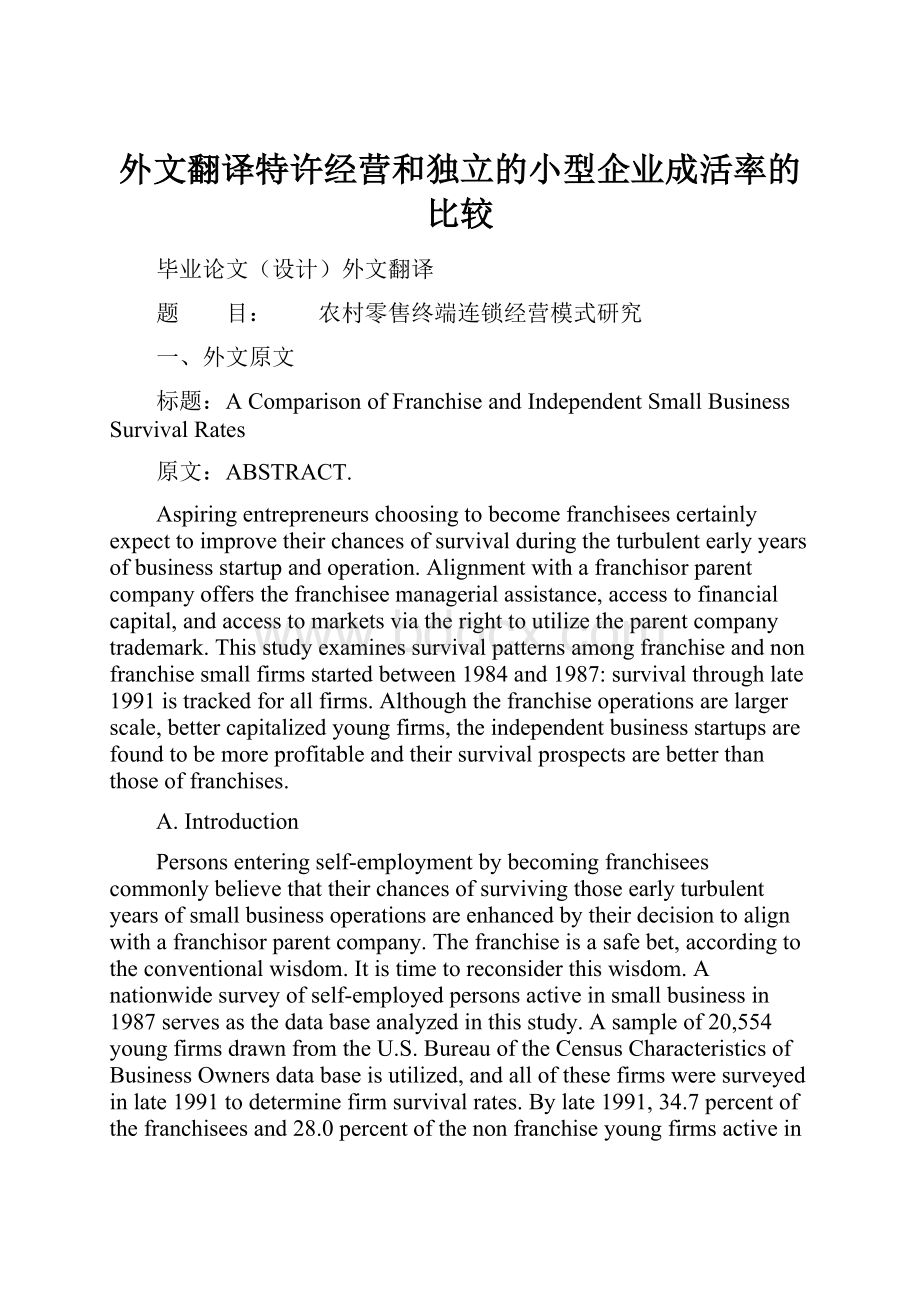外文翻译特许经营和独立的小型企业成活率的比较.docx
《外文翻译特许经营和独立的小型企业成活率的比较.docx》由会员分享,可在线阅读,更多相关《外文翻译特许经营和独立的小型企业成活率的比较.docx(10页珍藏版)》请在冰豆网上搜索。

外文翻译特许经营和独立的小型企业成活率的比较
毕业论文(设计)外文翻译
题 目:
农村零售终端连锁经营模式研究
一、外文原文
标题:
AComparisonofFranchiseandIndependentSmallBusinessSurvivalRates
原文:
ABSTRACT.
Aspiringentrepreneurschoosingtobecomefranchiseescertainlyexpecttoimprovetheirchancesofsurvivalduringtheturbulentearlyyearsofbusinessstartupandoperation.Alignmentwithafranchisorparentcompanyoffersthefranchiseemanagerialassistance,accesstofinancialcapital,andaccesstomarketsviatherighttoutilizetheparentcompanytrademark.Thisstudyexaminessurvivalpatternsamongfranchiseandnonfranchisesmallfirmsstartedbetween1984and1987:
survivalthroughlate1991istrackedforallfirms.Althoughthefranchiseoperationsarelargerscale,bettercapitalizedyoungfirms,theindependentbusinessstartupsarefoundtobemoreprofitableandtheirsurvivalprospectsarebetterthanthoseoffranchises.
A.Introduction
Personsenteringself-employmentbybecomingfranchiseescommonlybelievethattheirchancesofsurvivingthoseearlyturbulentyearsofsmallbusinessoperationsareenhancedbytheirdecisiontoalignwithafranchisorparentcompany.Thefranchiseisasafebet,accordingtotheconventionalwisdom.Itistimetoreconsiderthiswisdom.Anationwidesurveyofself-employedpersonsactiveinsmallbusinessin1987servesasthedatabaseanalyzedinthisstudy.Asampleof20,554youngfirmsdrawnfromtheU.S.BureauoftheCensusCharacteristicsofBusinessOwnersdatabaseisutilized,andallofthesefirmsweresurveyedinlate1991todeterminefirmsurvivalrates.Bylate1991,34.7percentofthefranchiseesand28.0percentofthenonfranchiseyoungfirmsactivein1987haddiscontinuedoperations.Furtherindependentbusinessvs.franchiseecomparisonsrevealthattheyoungfirmsstarted
Withoutthebenefitofaparentfranchisorweresignificantlymoreprofitablethanthefranchisefirms.Inshort,thefranchiseroutetoself-employmentisassociatedwithhigherbusinessfailureratesandlowerprofitsthanindependentbusinessownership.Thisstudydescribesvariousownertraitsandoperationalcharacteristicsoffranchiseandnonfranchiseyoungfirms.Logisticregressionequationsareutilizedtoisolatetheimpactofthefranchisecharacteristiconfirmsurvivalprospectswhenownerandfirmtraitsarecontrolledfor.Itisthelargerscale,bettercapitalizedfirmsheadedbycollegegraduateownersworkingfull-timeintheirsmallbusinessesthataremostlikelytoremaininoperation;thefranchisetrait,otherfactorsconstant,exhibitsahighlynegativerelationshiptofirmsurvivalprospects.Separateanalysesofminority-ownedfranchiseandindependentsmallbusinesssubsamplesrevealthatsurvivalpatternsamongminority-ownedfirmscloselyresemblethosepresentintheoverallsmallbusinessuniverse:
franchiseoperationsaremorelikelytogooutofbusinessthanindependentfirmstartups.Thecomprehensivecross-sectionandtimeseriesdataonyoungsmallbusinessesanalyzedinthisstudyaredrawnfromalargenationwidesmallbusinessdatabase-theCharacteristicsofBusinessOwners(CBO)database-thatwascompiledbytheU.S.BureauoftheCensusin1992.OnelimitationoftheCBOdatabaseisitsexclusionoffirm’sfittingtaxreturnsasregularcorporations:
theCBOincludesonlyproprietorships,partnerships,andS-corporationtillers
B.Measuringsurvivalpatternsamongyoungsmallbusinesses:
Databaseconsiderations
Mostevidenceonfranchisesurvivalratesisforthcomingfromjournalisticsources.Arecentadinbusinessweek,forexample,claimedthat"afranchiseehasafourtimesgreaterchancetosucceedthananentrepreneurwholaunchesanewindependentbusiness."Factualunderpinningsforthisclaimwerenotapparent.Attheotherendofthejournalisticspectrum,theFebruary1994issueofmagazineclaimsthat50.7percentofDecoratingDen'sfranchiseesterminatedoperationsduringthethreeyearperiodendinginDecember1992.DecoratingDenisafranchisorthatgrewspectacularlyduringthe1980s;itsfranchiseesinvestbetween$17,000and$50,000tolaunchtheirfirms.
BusinessfailureratefiguresdisseminatedbyindividualfranchisorsandtheInternationalFranchiseAssociationsuggestthat92percentoffranchisebusinessstartupsarestillinbusinessattheendoffiveyears,versusonly23percentoftheindependentfirms.Suchpromotionalbusinessfailureratefigurescitethe"U.S.DepartmentofCommerce"astheirsource.Infact,theU.S.DepartmentofCommercehas,untilrecently,conductedannualssurveysoffranchisorsandpublishedtheresultsinbiennialreports,franchisingintheeconomy.AccordingtothestaffoftheU.S.HouseofRepresentativesCommitteeonSmallBusiness,however,acomprehensivereviewofthefranchisingintheeconomyreports"failstoshowanyfiguresprovidingcomparablefailureorsuccessratesforfranchisesorfranchisees.Onthecontrary,thereportsnotespecificallythat'thenumberoffailuresisunknown'(franchisingintheeconomy,1988),".MyownreviewofapplicableU.S.DepartmentofCommercepublicationsrevealsnostudiesorstatisticscapableofsupportingcomparativesurvivalratesfornewfranchiseversusindependentbusinessstartups.ClaimsthatfranchisestartupshavevastlyhighersurvivalratesthanindependentbusinessstartupscannotbesupportedbypublishedU.S.DepartmentofCommercestudiesofsmallbusiness.Thus,claimsaboutfranchiseratesofsurvivalhaveoftentendedtoextremes.Thepurposeofthisstudyistoraisethedebatetoahigherplain.ThepresenceOftheCBOdatabasemakesitpossibleforissuesoffranchiseesurvivaltobeanalyzedinobjective,comprehensiveways.TheCBOoversamplesminorityandwomenbusinessowners,anditoversamplesthelargerscalesmallbusinessesthatutilizepaidemployees.Oftheroughly90,000smallbusinessessurveyedtocreatetheCBOdatabase,over70percentresponded.Allofthereportedstatisticsinthisstudyareweightedtoadjustforbothsurveynonresponsive,andtheCensusBureau'snonrandomsamplinginthecreationoftheCBO:
thefirmsdescribedinthisstudyarethereforerepresentativeofyoungfirmsthatgrossedatleast$5000intotalrevenuesin1987.Thisstudycoversonlyfirmsformedoverthe1984--1987periodandtheunitofanalysisisfirms,notpersons.Thus,theuniverseoffirmscoveredinthisstudyis4,005,561smallbusinesses.AdescriptionoftheCBOsampleofyoungfirmsanalyzedinthefollowingpagesappearsintheappendixofthisstudy.Thesampleoffranchisefirmsanalyzedhere’snotidenticalwiththeuniverseoffranchiseunitsopenedbetween1984and1987forseveralreasons.First,somefranchiseunitsareownedbythefranchisor.Second,somenewfranchiseunitsareownedbymulti-unitfirmsthatbeganoperationsbefore1984.Third,multi-unitnewfirmsincludedinthisstudymightownfranchiseoperationsatseverallocations,butsuchafirmisonlycountedonce,becausetheunitofanalysishereisthefirm.Thus,thefailurerateforallnewfranchiseunitsoperatingin1987thatopenedupbetween1984and1987maydifferfromtheclosureratereportedinthisstudy.
C.Characteristicsoffranchiseandindependentyoungfirms
Existingstudiesidentifytraitsthatarepositivelycorrelatedwithfirmlongevity.Thelargerscale,oldersmallbusinesseshavehighersurvivalratesovertimethansmaller,youngerfirms(Evans,1987;BatesandGucci,1989).Amongveryyoungfirms,ownertraitsassociatedwithgreaterlikelihoodofsurvivalincludeownersworkingfull-timeinthefirm,highlyeducatedowners,andlargeownerfinancialcapitalinvestmentinthefirmatstartup(Bates,1990a).Tableoneindicatesthatfranchiseesaregenerallybetterendowedwithtraitslinkedtosurvivalthannofranchiseyoungfirms.Intermsofmean1987salesrevenues,theyoungfranchiseesreport$513,961,overfivetimeslargerthanthecorrespondingfigureof$102,410reportedbytheindependentbusinesses(tableone).Capitalizationatstartupissimilarlymuchgreater-meanvalue--$86,493-forthefranchisefirms,almostthreetimesgreaterthanthenofranchisefirmcapitalizationof$29,822.Onlyintheareaofownereducationalbackgrounddothefranchisefirmsappeartobeweakerthantheindependents:
9.1percentoftheformerand16.2percentofthelatterhadpursuedgraduatestudiesbeyondthebachelor'sdegree.AlloftheabovegroupmeandifferencesarestatisticallysignificantYet,despitetheobviousstrengthsoftheyoungfranchisefirmssummarizedintableone,theyaredramaticallylessprofitablethanindependentfirmsofthesameage,andtheyexhibitalowersurvivalrate-65.3percent(versus72.0percentfornofranchisefirms)-overthe1987-1ate1991timeperiod;thesedifferencesarestatisticallysignificantatconventionallevels.Aspiringentrepreneurschoosingtobecomefranchiseescertainlyexpecttoimprovetheiroddsofsurvivalovertheearlyturbulentyearsofbusinessstartup.Beyondlowriskoffailure,whatspecificallydoesthepotentialownerseektogainbypurchasingafranchiseratherthanoperatinganindependentbusiness?
Rubin(1978)listshypothesizedadvantagesaccruingtofranchisees.Firstthetrademarkandtheproductsoldappeartobevaluable,whichfacilitatesaccesstocustomersfortheyoungfranchisee.Second,thefranchisoroftenmakescapitalavailabletothefranchisee,eitherbyextendingcreditdirectlyorco-signingforabankloan.Third,franchiseeslackingappropriatehumancapitalcanreceivemanagerialadviceandassistancefromfranchisors.Tableonesummarystatisticsprovideevidencethatisconsistentwiththesehypothesizedadvantagesofthefranchiserelationship.Franchiseesaregeneratinggreatersalesperun